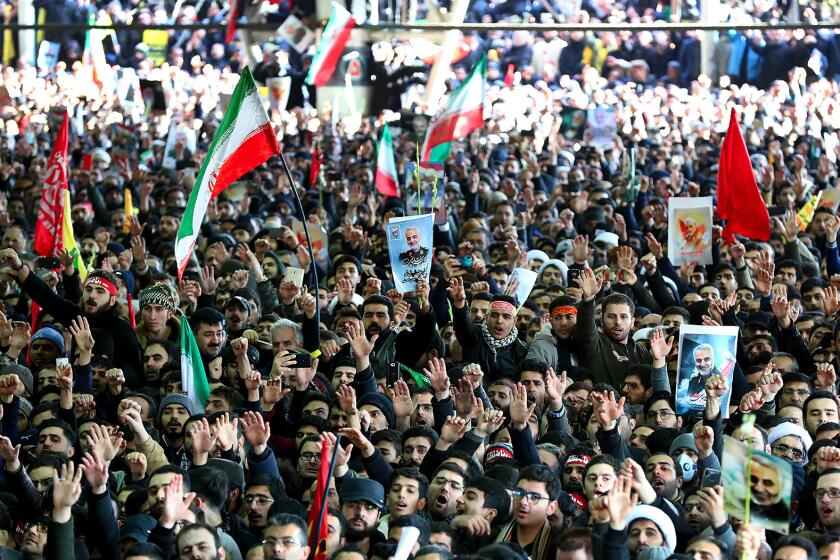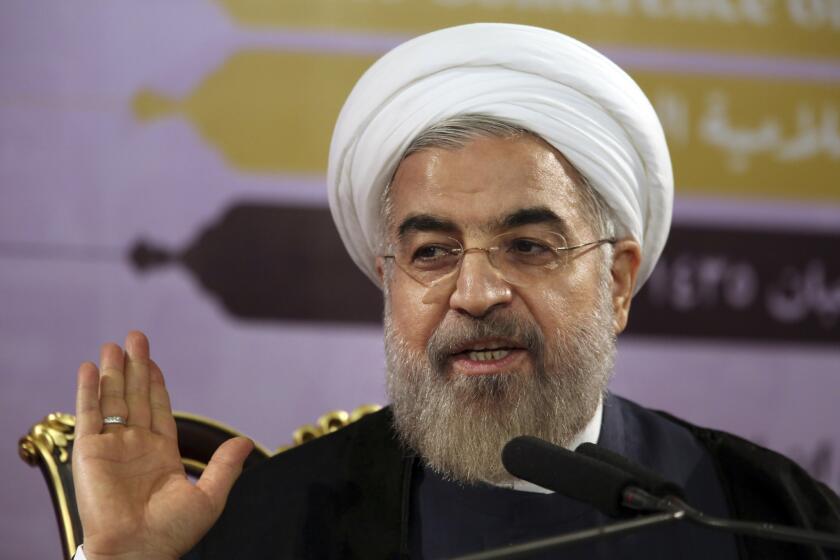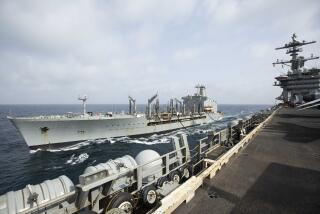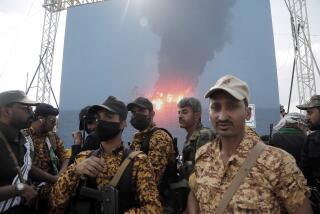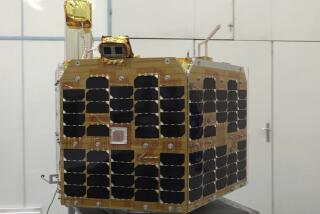Iran fires missile at mock aircraft carrier amid growing tensions with the U.S.
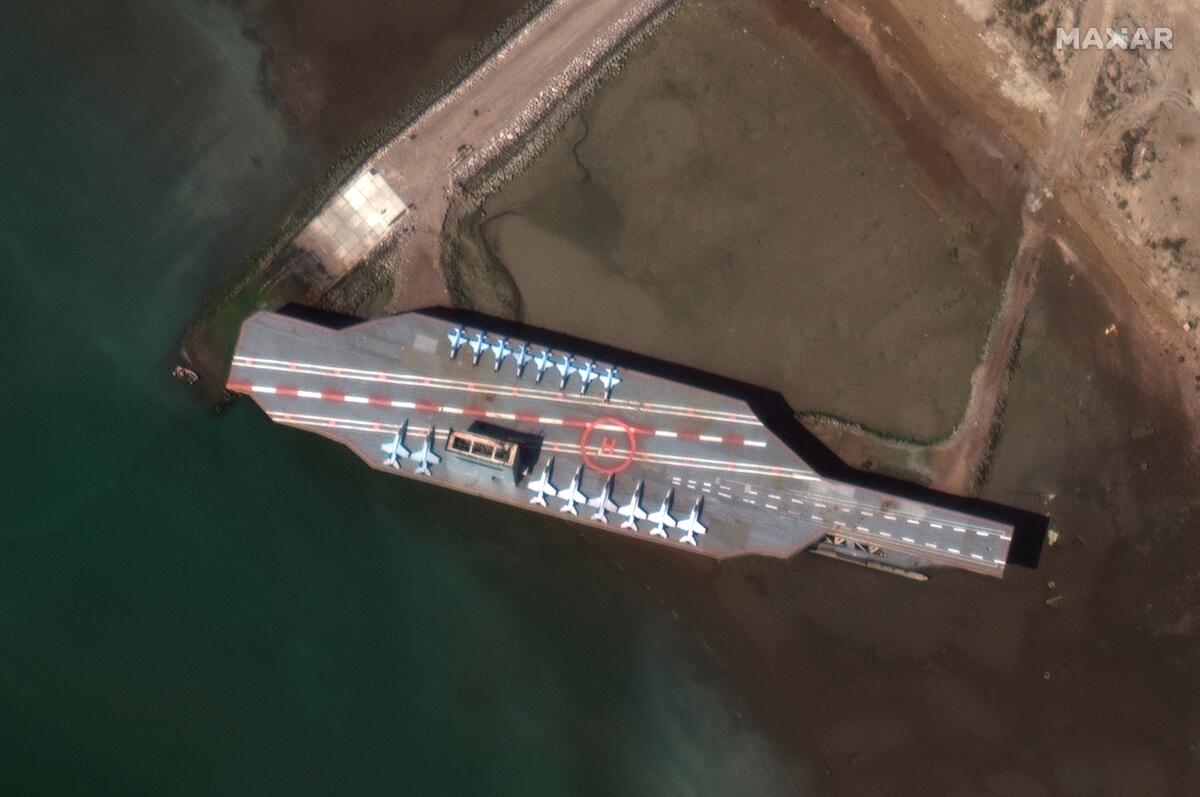
TEHRAN — Iran’s paramilitary Revolutionary Guard fired a missile from a helicopter targeting a replica aircraft carrier in the strategic Strait of Hormuz, state television reported Tuesday, in an exercise aimed at threatening the U.S. amid tensions between Tehran and Washington.
The drill, in a waterway through which 20% of all traded oil passes, underlines the lingering threat of military conflict between Iran and the U.S. after last summer saw a series of incidents targeting oil tankers in the region. In January, a U.S. drone strike killed a top Iranian general in Baghdad, to which Tehran responded by firing ballistic missiles at American forces in Iraq.
While the COVID-19 pandemic has engulfed both Iran and the U.S. for months, there have been increasing signs of a confrontation as America argues to extend a years-long U.N. weapons embargo on Tehran that is due to expire in October. A recent incident over Syria involving an American jet fighter approaching an Iranian passenger plane also has renewed tensions.
Iranian commandos fast-roped down from a helicopter onto the mock aircraft carrier in the footage aired Tuesday from the exercise called “Great Prophet 14.” Other footage showed fast boats encircling the replica ship, kicking up white waves in their wake.
Iranian troops also fired anti-aircraft batteries at a drone target in the exercise from a location that state television described as being near the port city of Bandar Abbas. Troops fired missiles launched from trucks on land and fast boats at sea, as well as shoulder-fired missiles.
The Guard will use “long-range ballistic missiles with the ability to hit far-reaching aggressor floating targets” during the drill, said Abbas Nilforoushan, the guard’s deputy commander for operations, according to Revolutionary Guard website sepahnews.com. That suggests the drill could see a repeat of what happened in 2015, when the guard sank a replica target.
Trump and Khamenei are at least constrained by a similar desire: to stay in power.
It wasn’t immediately clear if all the footage was from Tuesday, as one overhead surveillance image that appeared to be shot by a drone bore Monday’s date.
“Our policies to protect the vital interests of the dear nation of Iran are defensive, in the sense that we will not invade any country from the beginning, but we are completely aggressive in tactics and operations,” Gen. Hossein Salami, the head of the guard, was quoted as saying. “What was shown today at this exercise at the level of aerospace and naval forces was all offensive.”
State TV footage also showed the guard’s scuba forces underwater, followed by a cutaway to a blast hole just above the waterline on the replica carrier.
That appeared to be a not-so-subtle reminder of U.S. accusations last year that Iran planted limpet mines on passing oil tankers near the strait, which exploded on the vessels in the same area. Iran has repeatedly denied the actions, though footage captured by the American military showed guard members removing an unexploded mine from one vessel.
Iran’s leader says a newly discovered oil field contains some 53 billion barrels that would be added to its known reserves of roughly 150 billion.
The replica used in the drill resembles the Nimitz-class carriers that the U.S. Navy routinely sails into the Persian Gulf from the Strait of Hormuz, the narrow mouth of the waterway. The Nimitz, the namesake of the class, just entered Mideast waters late last week from the Indian Ocean, likely to replace the Dwight D. Eisenhower in the Arabian Sea.
It remains unclear when or if the Nimitz will pass through the Strait of Hormuz or not during its time in the Mideast. The Abraham Lincoln, deployed last year as tensions initially spiked, spent months in the Arabian Sea before heading through the strait. The Eisenhower came through the strait early last week.
To Iran, which shares the strait with Oman, the American naval presence is akin to Iranian forces sailing into the Gulf of Mexico near the coast of Florida. But the U.S. Navy stresses that the strait is an international waterway crucial to global shipping and energy supplies. Even though the U.S. now relies less on Mideast oil, a major disruption in the region could see prices rapidly rise.
More to Read
Sign up for Essential California
The most important California stories and recommendations in your inbox every morning.
You may occasionally receive promotional content from the Los Angeles Times.
